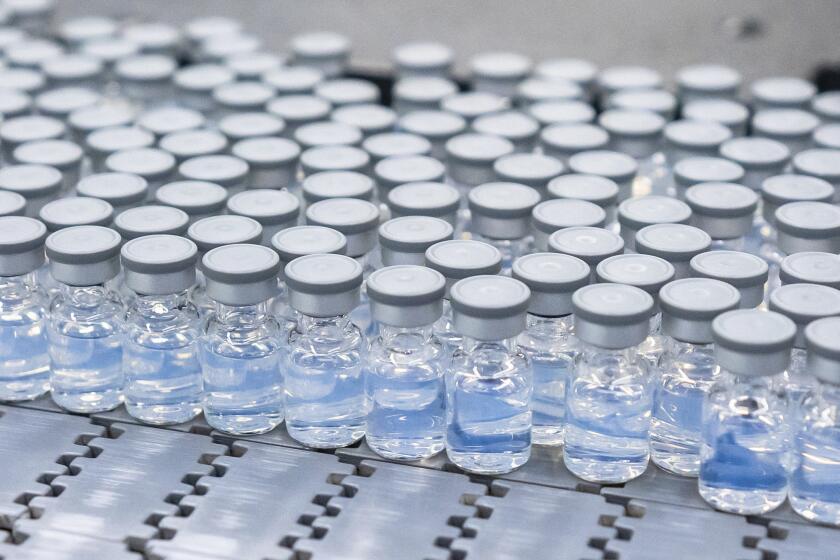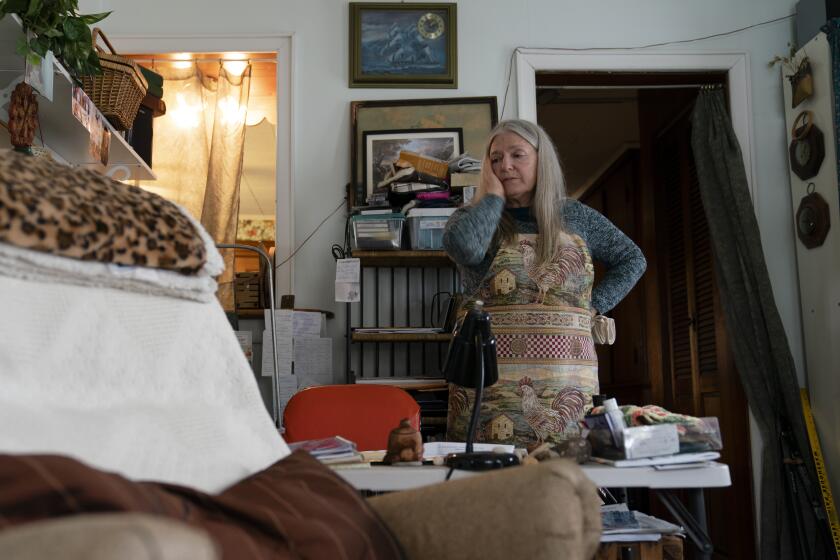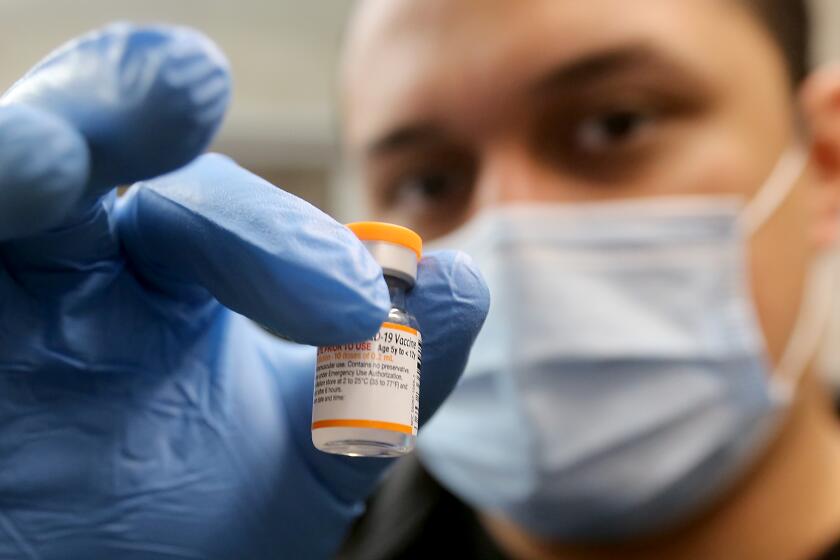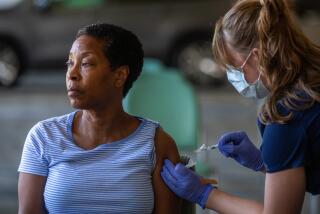It’s very easy to get a COVID-19 Omicron booster in California. Here’s how
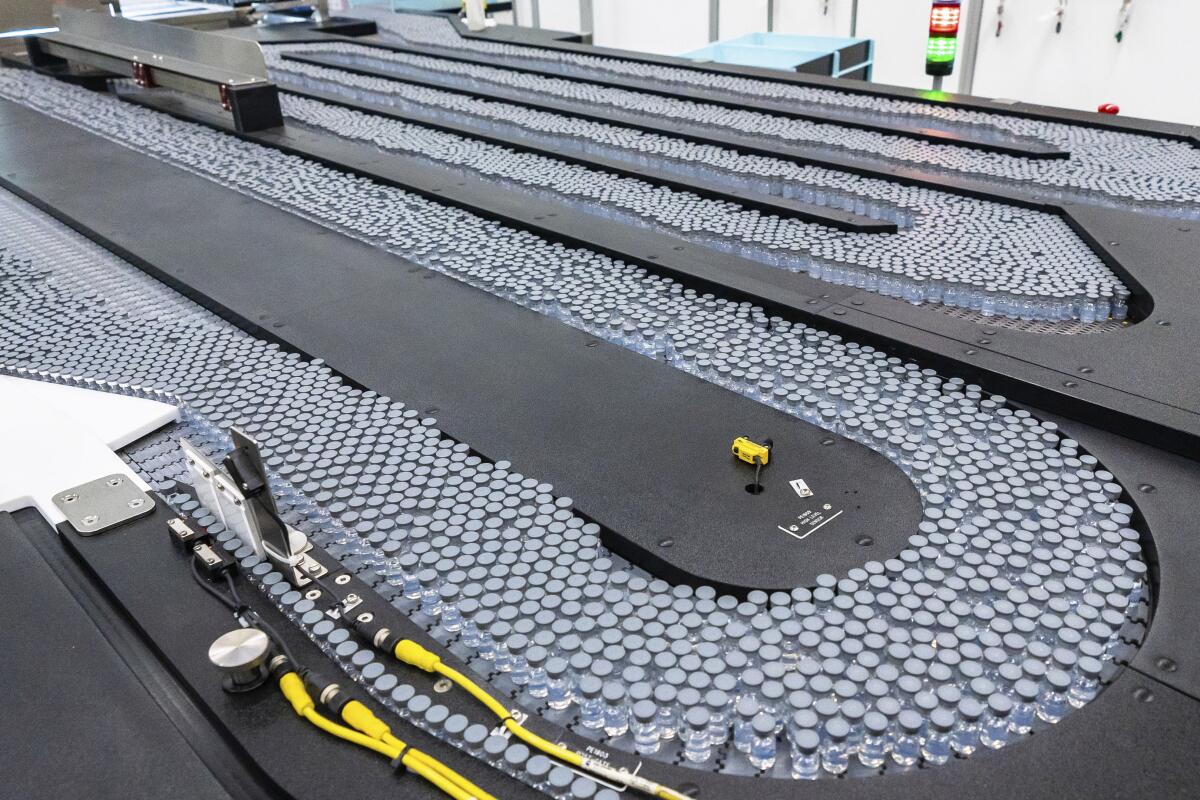
Updated COVID-19 Omicron boosters are abundant in Los Angeles County, and officials are urging people to get the latest offering before the holidays.
More than half a million doses have already arrived in the region, with tens of thousands more on the way, according to Public Health Director Barbara Ferrer. They are available at more than 1,500 sites countywide, including those affiliated with the county Department of Public Health, health clinics and retail pharmacies.
The priority, at this point, “remains ensuring easy access to these new boosters for everyone who’s eligible, and we remain especially focused on ensuring good access to the new boosters in the hardest hit communities,” Ferrer told the county Board of Supervisors on Tuesday.
“We’re really grateful that we have this booster to provide us with even more protection against serious illness in L.A. County as we enter this fall,” she added.
Whenever you opt to roll up your sleeve, it’s important to note that it takes two weeks for the full effect of the booster to hit.
Nearly 70% of L.A. County’s 10 million residents are already eligible for the new boosters, which are also called bivalent because they’re designed to protect not only against the original coronavirus strain, but also the Omicron subvariants BA.5 and BA.4, which have dominated the nation this summer.
Robust uptake of the updated booster could help limit the severity of a fall-and-winter wave, officials and experts say.
“This booster will increase protection against severe disease, and may provide additional protection from getting infected — hopefully allowing us to enjoy the fall and holiday season with less disruption and illness,” Ferrer said.
How significant demand is remains to be seen, however. Statewide, 72.1% of Californians have already completed their primary vaccination series, but just under 59% of those eligible have been previously boosted, according to data from the state Department of Public Health.
Vaccination providers need to make sure they’re administering the right vaccination to the right person, panel of health expert cautions.
The U.S. Centers for Disease Control and Prevention has presented survey data suggesting that 72% of respondents said they were likely to receive an updated booster. Still, some health officials wonder whether COVID-weary residents will feel a sense of urgency to get yet another shot.
“Another thing that we are trying to combat is COVID fatigue — so many people who are just tired of thinking about COVID want to move on. They’re tired of considering whether they need to get more shots. Perhaps they’re confused as to whether they should. Maybe they got some shots to begin with, the two doses, maybe a booster, but they don’t want to keep going because they seem to think that there’s just no end to all this vaccination,” Dr. Maggie Park, San Joaquin County’s public health officer, said during a recent briefing hosted by California’s Vaccinate All 58 campaign.
Park and other health officials, including at the federal level, have pointed out that flu shots have become an annual tradition for many, and the same may be true of COVID-19 vaccines, at least in the near term.
“It is becoming increasingly clear that, looking forward with the COVID-19 pandemic, in the absence of a dramatically different variant, we likely are moving toward a path with a vaccination cadence similar to that of the annual influenza vaccine, with annual, updated COVID-19 shots matched to the currently circulating strains for most of the population,” Dr. Anthony Fauci, the U.S. government’s top infectious disease expert, said. “However, some — particularly vulnerable groups — may continue to need more frequent vaccination against COVID-19.”
The new Omicron COVID-19 vaccine is useful but shouldn’t skew our expectations of the pandemic’s future.
The new booster offers “a chance to make a real dent in the legions of vaccinated folks, particularly older people, experiencing breakthrough infection,” Dr. Peter Chin-Hong, a UC San Francisco infectious disease expert, wrote in an op-ed published in The Times.
Unvaccinated people still make up the majority of patients who’ve died from COVID-19, but even vaccinated people can die from the disease, especially if they’re at higher risk and haven’t received any booster shots. COVID-19 may end up causing 100,000 deaths a year nationwide — several times the fatalities of the typical flu season and possibly greater than annual deaths from diabetes, Chin-Hong wrote.
“Vaccinated patients who die have disproportionately been those 75 and older who have not received a booster,” he wrote. “When talking to families of vaccinated individuals who died, I’ve often learned that the patient rushed to get their first two shots after the vaccine was authorized in December 2020 but had not received a booster.”
A new research initiative will explore whether the persistence of coronavirus in the body plays a role in the development of long COVID.
Someone is eligible for an updated booster if she or he has completed their primary vaccination series and is at least 12 years old and two months out from their last shot. It doesn’t matter how many previous booster doses you’ve received.
Those age 12 and older can no longer receive the previous booster formulation.
The COVID-19 vaccine, including the updated boosters, “continue to be available for free to all people, regardless of insurance,” the California Department of Public Health said in a statement to The Times.
Some clinics may have stopped providing COVID-19 vaccines to people who don’t have insurance, given that Congress has failed to authorize more money to reimburse vaccine administrators for the cost of injections. Still, “no person can be charged to receive a COVID-19 vaccine,” the state health agency has said.
New boosters to protect against the latest Omicron variants of the coronavirus are arriving in Southern California this week. Here’s how to get one.
Here’s a rundown of how to get vaccinated:
Retail stores such as CVS, Walgreens, Rite Aid, Walmart and Ralphs are offering the new booster, the companies say on their websites. Check with specific stores for availability.
Los Angeles County: A list of clinics can be found at vaccinatelacounty.com or by calling (833) 540-0473, seven days a week, between 8 a.m. and 8:30 p.m. People who cannot leave their home can call the county and ask officials to send a vaccination worker to administer the shot at home. Long Beach’s health agency operates its own booster clinics; information can be found at (562) 570-4636.
San Diego County: Walk-in booster shot clinics run by the county public health department are available across the county.
Orange County: Booster shot appointments can be made at othena.com. (714) 834-2000.
Riverside County: Bivalent booster clinics are now in operation (951) 358-5000.
San Bernardino County: The updated booster is now available at a collection of sites. (909) 387-3911.
Ventura County: The updated booster is available at the county’s public health clinics in Oxnard and at a selection of mobile clinics.
Because it takes at least two weeks for the booster’s effects to offer full protection, officials are urging people to get the vaccine in advance of the fall-and-winter holiday season, when an increase in coronavirus cases is possible. During the first fall-and-winter season of the pandemic — in 2020 — cases of coronavirus in L.A. County began increasing in November and accelerated sharply in December; last year, cases dramatically increased in December.
For now, coronavirus cases are continuing to decline in the county. At the height of the summer Omicron wave, L.A. County was averaging nearly 6,900 cases a day. But for the seven-day period that ended Friday, L.A. County was averaging about 1,700 coronavirus cases a day, a 4% decrease from the prior week.
On a per capita basis, that’s 116 cases a week for every 100,000 residents.
If the case rate falls under 100 cases a week for every 100,000 residents, the L.A. County Department of Public Health plans to end the local requirement that riders wear masks aboard public transit or in transportation hubs, such as Los Angeles International Airport and Hollywood Burbank Airport.
That threshold is roughly equivalent to about 1,400 coronavirus cases a day in L.A. County.
Once the case rate falls under that threshold, county health officials also plan to end its recommendation for universal masking in indoor public settings and businesses. Instead, health officials say doing so would be a matter of personal preference.
Officials would still strongly recommend that certain individuals — including older or unvaccinated residents, and those with underlying health conditions or who live in high-poverty areas — mask up in higher-risk settings. Such spaces include those with poor air flow, are crowded or involve close contact with others.
The county would also still strongly recommend riders wear masks on public transit and transportation hubs, given the crowded conditions that can occur in those settings.
An analysis of death certificates from January to April showed COVID-19 deaths were nine times those caused by motor vehicles and more than five times the rate for flu and pneumonia.
Only a handful of transit agencies or local governments still require riders to wear masks. They include BART, which runs a 50-station, 131-mile commuter rail system in the San Francisco Bay Area; and AC Transit, which operates buses in East Bay communities such as Oakland, Fremont, Hayward and Berkeley.
New York Gov. Kathy Hochul ended a requirement to wear masks on public transit in her state earlier this month. New York City’s subway and bus system decided to make mask wearing optional, and free masks are still be available at subway station booths and on commuter railroad trains.
The California Department of Public Health still strongly recommends universal masking in indoor public settings.
Ferrer said L.A. County will retain its requirement that people mask up if they were a “close contact” of someone with a coronavirus infection, defined as someone who shared the same indoor space with an infected person for at least 15 minutes over a 24-hour period.
L.A. County requires such people to wear a mask around others for 10 days after an exposure.
The county’s rule is similar to one issued by the California Division of Occupational Safety and Health, also known as Cal/OSHA. The state agency requires that employees exposed to the coronavirus wear a mask for 10 days at work after the exposure.
L.A. County also requires that people who have been infected with the coronavirus, but no longer are required to isolate at home, remain masked between the sixth and 10th day after the onset of symptoms or their first positive test.
Infected people are required to stay home in L.A. County for the five days following onset of symptoms or their first positive test result. They can exit isolation as early as the sixth day if they receive a negative rapid test result. They can also exit isolation on the 11th day without needing a negative test result.
More to Read
Sign up for Essential California
The most important California stories and recommendations in your inbox every morning.
You may occasionally receive promotional content from the Los Angeles Times.
